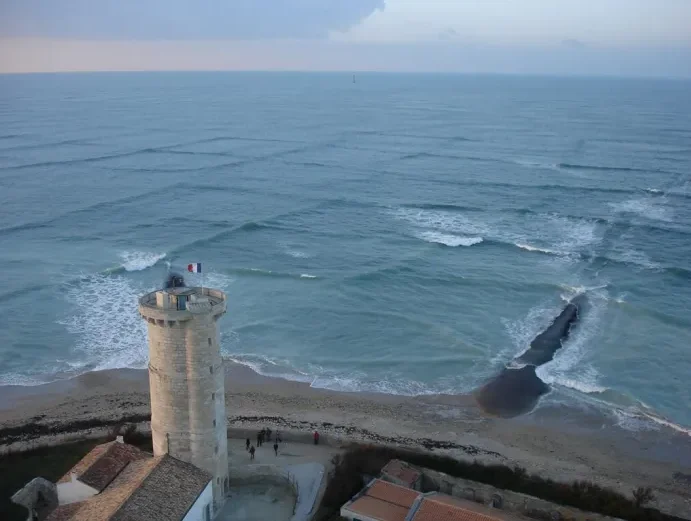The Captivating Beauty and Hidden Danger of Cross Seas
Nature never ceases to amaze with its ability to produce breathtaking phenomena, offering us moments of awe and wonder. Among these marvels is the striking display of cross seas—a rare and visually stunning oceanic pattern where waves intersect to create intricate, grid-like formations.

Cross seas occur when two wave systems converge at angles greater than 45 degrees, or when wind-driven waves clash with a swell traveling in a different direction. While these watery grids are undeniably beautiful, they are also deceptively dangerous, posing serious risks to both swimmers and vessels.
Beneath their enchanting surface lies a hazardous reality. The currents generated by cross seas can be unpredictable and powerful, making them perilous for those in the water. Navigating a boat or ship through these conditions is especially challenging, often leading to accidents and shipwrecks. Experts attribute many maritime incidents to the dangers of cross seas.
A 2010 report by the European Space Agency highlighted how frequently these conditions occur, particularly when wind-driven waves and swells overlap. According to a 2004 study cited by the agency, a significant proportion of ship accidents were linked to crossing sea states, underscoring the need for caution in these waters.
One location where this phenomenon is particularly visible is along the western coast of France, especially near Île de Ré. Tourists flock to witness the mesmerizing patterns, though entering the water is strongly discouraged due to the extreme risks. Instead, visitors can safely admire the view from a lighthouse on the island’s western side.
Cross seas serve as a reminder of nature’s duality—its ability to inspire wonder while demanding respect for its inherent dangers. For a closer look at this extraordinary phenomenon, check out the video below. Nature’s beauty continues to captivate us, blending awe with caution.
Pittie Mom Can’t Stop Crying For Her Puppies After Being Abandoned At Shelter

When Cinnamon – a red nose Pitbull girl – was dumped at the Charlotte Mecklenburg Animal Care & Control shelter in North Carolina, she was absolutely heartbroken.
She had been abandoned without her babies, and every time anyone stopped to talk to her, tears filled her eyes.
This sad Pitbull mama caught the eyes of one volunteer, who then decided to film a short video of her and post it on Facebook.
Only 48 hours later, the life of Cinnamon completely changed.
Cry Of A Broken Heart


Subscribe to the Dog Lovers Club!
Sarah Jennings Sleime, normally a volunteer for the Greater Charlotte SPCA, decided one Saturday that she was going to make a spontaneous trip to animal control to check out a couple of dogs for rescue.
She had no idea that one dog in particular was going to break her heart.
“I walked the kennels and a pit bull caught my eye… she was sitting up, kind of slumped-over, almost human-like,” Sleime wrote in her Instagram post.
It was pretty obvious that she recently had puppies and was completely heartbroken since her puppies weren’t there with her.
“[The shelter workers] believe she was confined and used as a breeding machine. She’s obviously had many, many litters,” Sleime told The Dodo.
She then bent over and started to talk to Cinnamon, but each time she did so, Cinnamon’s eyes filled with tears.
“It was the craziest phenomenon,” Sleime said.

In the absence of a foster home, the SPCA was unable to rescue any big dogs, but Sleime knew she had to do something to help this poor dog.
“I snapped some video footage of her “crying” and posted it to Facebook. 48 hours later, that video has been viewed 1 MILLION times and shared by 20k people,” Sleime wrote.
In only a day, Sleime’s inbox was filled with hundreds of messages about Cinnamon and her availability.
So many people wanted to adopt this pretty girl and give her a new life that will not be filled with tears.
Happily Ever After
Sleime’s friend, Meghan Connor Shelton, from Charlotte, North Carolina, was also among the hundreds of people to see Cinnamon’s video.
She told The Dodo:
“I have a special place in my heart for pit bulls. I think they’re a very misunderstood dog and a misunderstood breed. And when I saw her in that video, literally crying in a cage, I cried. My kids cried. I showed my husband, and he said we could go look at her tomorrow.”
The next morning, Shelton’s family was first in line to meet Cinnamon.
The whole family, including the children, were immediately in love with her. “It was love at first sight. She just kind of pulled at our heartstrings,” Shelton said.
They filled out the paperwork, and as soon as Cinnamon – now known as Rosie – was spayed, they brought her home.

The family already had another dog at home – a 3-year-old Pitbull male named Blu.
At first, they weren’t sure if the two would get along, especially since Rosie had suffered a lot in her life, but she surprised everyone.
“It was interesting because you never know how it’s going to go, but they just kind of sat next to each other with tails wagging,” Shelton said.

The two are now the best of friends, and they enjoy each other’s company. It’s like they’ve known each other their whole life.
As Rosie slowly got used to her new home and life, her personality also blossomed. According to the family, one of her most interesting characteristics is that “when she gets excited, she snorts like a pig”.
Rosie’s touching video not only secured her a new home, but it also helped many other dogs at the shelter find their forever home.

“Small acts have a big impact: Not only was this sweet dog, Cinnamon, adopted the next morning, but other families who came to adopt her saved other dogs at the shelter, freeing up kennels for strays and owner surrenders waiting in the back who would have certainly been euthanized as the shelter is full,” Sleime said.
One simple video or a photo can reach millions of people and in a matter of seconds, change someone’s life.
Visit the CMPD Animal Care and Control page, and the Greater Charlotte SPCA’s website for more information about adoptable dogs for an opportunity to save another pup’s life just like Rosie’s was saved.



Leave a Reply